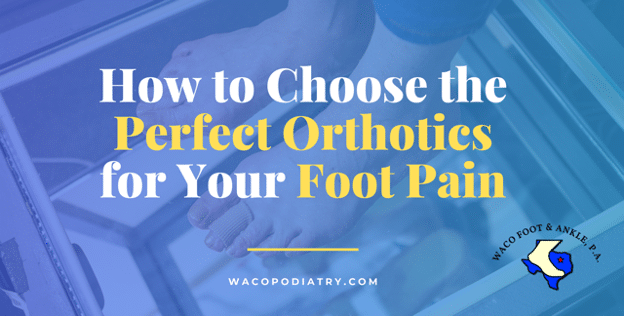How to Choose the Perfect Orthotics for Your Foot Pain
If you are thinking of using orthotics to address persistent cases of foot pain or heel pain, it may be awfully tempting to head over to the local drug store.
Because hey, there are often plenty of premade, prepackaged orthotic inserts just waiting for you on the shelves. Some places even have a neat kiosk station you can stand on to get a recommendation of what to buy!
If you want to give that a try, we won’t try to stop you. Just don’t be surprised if they end up not working all that well for you.
The best orthotics for a patient’s foot and ankle needs have a lot more attention put into them than you can get at a store. They require a comprehensive understanding of the problem(s) that need to be addressed and the knowledge of how to best solve them.

Knowing What Your Feet Need
Orthotics do not have the same functions as bandages or medications. You don’t put them on until the problem disappears and then throw them away.
Instead, you can think of orthotics more like a support you might give to a wobbly table. Orthotics address an imbalance or imperfection in the structure, but don’t heal it. Removing the support will expose you to the same problems as before.
Also, not all wobbly tables are built the same, so to speak. The best support will be custom made to an individual table, and custom orthotics are made to best suit each individual’s unique foot shape. There is no such thing as “one size fits all” with custom orthotics. It’s very much “one size fits one.”
To know how custom orthotics could best help your condition (if they are the best treatment option for your condition), we need to understand all we can about your circumstances. And, as you might suspect, that requires a lot more than just you stepping on a pressure plate.
Don’t get us wrong. Knowing how standing pressure is distributed across your feet is an important element of diagnosis and treatment. But a plate at the store is not going to be able to see how weight shifts across your feet as you walk and whether your gait (i.e. the way you walk) also exhibits any abnormalities.
You also can’t tell a pressure plate how your symptoms actually feel, when they are at their worst, and how they affect your daily life. It can’t determine whether you are a teacher or factory worker forced to spend all day on their feet (and on what types of surfaces), or whether you are worried your pain will interfere with your desires to work out more or play sports.
All of these factors can play significant roles in determining whether orthotics should be prescribed for your feet and just what their composition should be. These are medical tools you would be using on a near-constant basis, whenever you wear shoes, so they should be tailored to your needs as best as possible!
Considering Composition of Custom Orthotics
We do truly mean it when we say that no two pairs of custom orthotics are created the same. The materials they are made from can depend on their intentions, and mere millimeters of difference in thickness can have significant impacts.
For example, two general categories of orthotics are functional and accommodative.
A functional orthotic is designed more toward keeping a patient’s gait in check. If your foot rolls inward too much when you walk, for example (overpronation), an orthotic can help limit that excess movement. Since they are more controlling in nature, a functional orthotic tends to be made of firmer materials.
An accommodative orthotic is designed more toward providing cushioning and redistribution of forces across the foot. Naturally, this requires softer materials.
However, a custom orthotic can offer both functions at varying degrees in different places. That’s why having an exact prescription can be so important.
It can also be important to have orthotics that can be adjusted and refurbished as necessary. Custom orthotics are built to last much longer than off-the-shelf brands. Even so, circumstances can change. Gains or losses in weight, as well as changes in mobility, can affect the usefulness of any orthotic over time. When you have custom orthotics that are checked every year or so at our office, we can adjust them as needed and prescribe new pairs—often covered by insurance.
Get the Full Attention and Comprehensive Care You Need
For something that can affect your daily life and goals as much as daily, persistent heel pain or foot troubles, you deserve better than a self-serve kiosk.
At Waco Foot & Ankle, we ensure the needs of every patient are fully listened to and understood, then recommend and follow through with personalized treatment to produce optimum results. That might include custom orthotics, or it might include other forms of treatment such as physical therapy, rest and icing, stem cell therapy, or laser therapy. The key is that you receive the most effective form of treatment for your needs.
Do not wait for help with foot and ankle pain! Call our office at (254) 776-6995 to schedule an appointment. Or, if you prefer to contact us electronically, fill out our online form and a member of our staff will respond during normal office hours.
